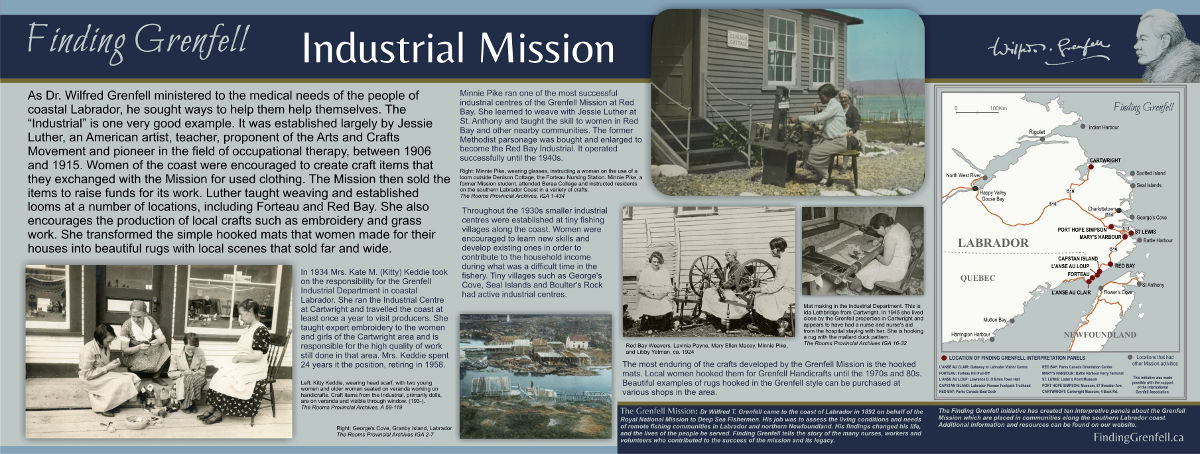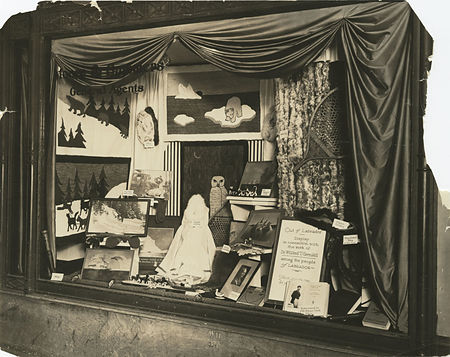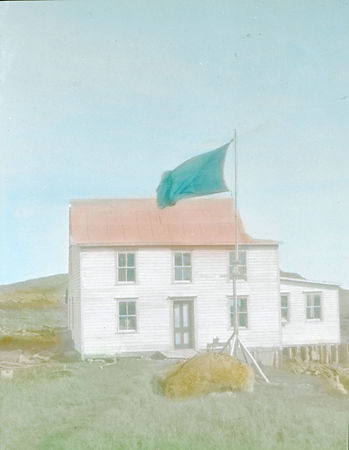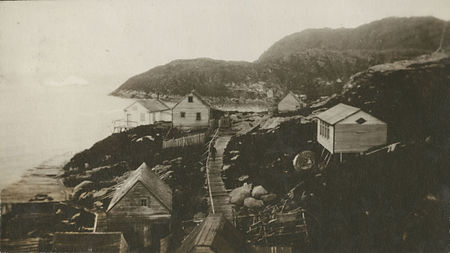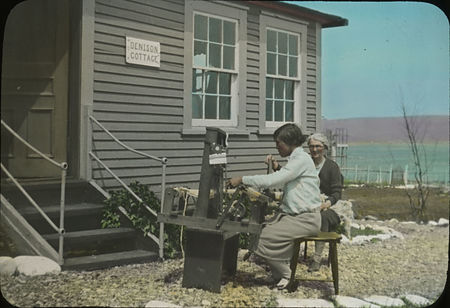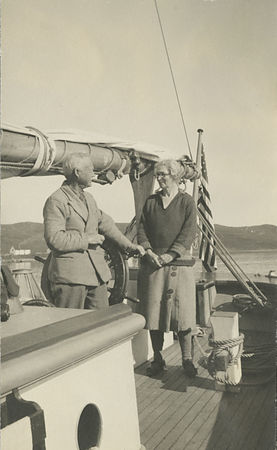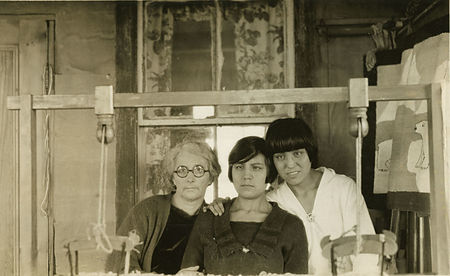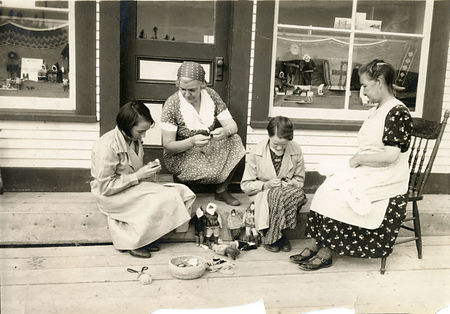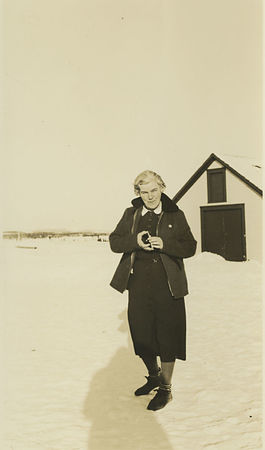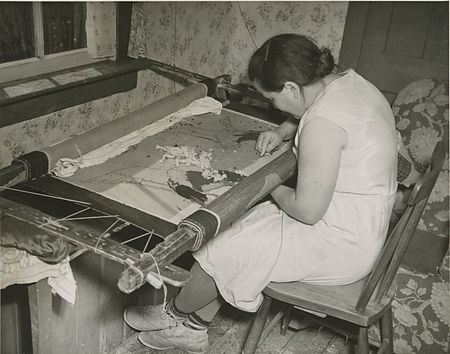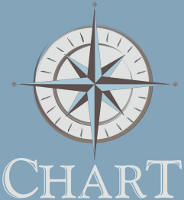Industrial Mission
In addition to his medical work and spiritual mission in Labrador, Sir Wilfred Grenfell was constantly seeking inspiration for ways to help people help themselves. He was also on the look-out for and recruiting volunteers who could help him do this. He found one such person in Jessie Luther, an artist and teacher with considerable experience in craft production from Providence, Rhode Island. She was also a champion of the Arts and Crafts movement — an attempt to counter the rapid changes associated with industrialization by encouraging a return to domestic handicrafts.
Grenfell met her in the Boston area in 1905 when he was observing her work in the early development of the field of occupational therapy. He immediately invited her to join his team. She travelled to St. Anthony in 1906 and spent much of the next 10 years developing a program of occupational therapy for patients as well as what became known as the "Industrial."
The basic premise of the Industrial was the production of handmade items by local women that were exchanged for clothing; the items were then sold by the Mission throughout Canada, the United States and United Kingdom to raise funds for its work.
Jessie Luther founded weaving centres at St. Anthony and other locations, including Forteau and Red Bay. She also encouraged the production of native embroidery and grass work in Labrador. By far, her most important contribution was the development of the hooked mat industry. Local women made simple mats for their homes by hooking old fabric through loops in burlap.
Inspired by colourfully designed rugs that she saw in rural New Hampshire, she introduced designs depicting local scenes that appealed to consumers outside the local area. When she resigned from the Grenfell Mission at the end of 1915 she left a well-organized enterprise with established markets for its products.
Outside St. Anthony, Red Bay had one of the most successful and continuous industrial centres run by Miss Mary (Minnie) Pike. Her association with Grenfell began with his first visit to Red Bay in 1892. She accompanied her father Levi when he piloted Grenfell's ship Albert the last few miles to Red Bay. Her dedication to Grenfell and his mission started that day; she assisted him when he visited the community and learned to administer first aid.
In 1910 Grenfell brought her to St. Anthony, where she became a member of his household. She learned to weave with Jessie Luther, who was teaching the skill to local women. Grenfell's wife Anne later arranged for her to attend Berea College in Kentucky to continue her training. When she returned to Red Bay she set up an industrial centre there. The former Methodist parsonage was acquired for the purpose and two looms were set up there. During the next two decades she trained women in the community to become talented weavers. The women also hooked rugs, and in 1929 they sent $670.00 worth of woven articles and rugs to St. Anthony to be sold by Grenfell Industries. Minnie Pike died 28 April 1943.
Minnie Pike was also known to teach weaving to other women in southern Labrador, including at Forteau. The women at Forteau were also known for making silk flowers, a skill taught to them by Sister Florence Bailey.
Grenfell operations at other communities along the south Labrador coast also encouraged industrial work among the local women, including Indian Harbour, Cartwright and the area around Battle Harbour and Mary's Harbour. The work of the Mission centred on providing medical services to the fishermen of the Labrador coast, and in summer there were thousands of them scattered among the coves and islands of the area. Efforts were made to reach them by setting up seasonal operations, and industrial work was encouraged at these locations as well. For example, during the summer of 1929 there were industrial centres operating at George's Cove, Boulter's Rock and Seal Islands.
It is likely that these centres were the result of a trip along the Labrador coast by Catherine E. Cleveland in 1923. The goal of the trip was to determine the possibility of craft development among the women of the coast in light of recent failures in the fishing and fur industries. She wanted to see what the women could do and the quality of their work, teach them how to do other crafts and provide them with materials to be used for production over the winter. For example, at Spotted Islands a class was started to learn Swedish darning to make borders for fancy bags.
Starting in 1934, Kate M. (Kitty) Wilson Keddie spent 24 years at Cartwright as head of the Grenfell Industrial Department for coastal Labrador. The daughter of a Hudson Bay Company factor, she spent much of her childhood at Rigolet, where Wilfred Grenfell was a welcome and frequent visitor to the Wilson family. As an adult she lived and worked in western Canada, where she married Philip Keddie. He died of the Spanish Flu at Cumberland House, SK in 1918; Mrs. Keddie was one of only three survivors in that community.
In 1931 she joined the Grenfell Mission at Northwest River and three years later took on the job with the Industrial Department at Cartwright. Mrs. Keddie ran the Industrial Centre there and travelled the coast once a year to visit industrial workers. She was responsible for the construction of the new and modern Lady Grenfell Memorial Industrial Building at Cartwright in 1951. As head of the Department, Mrs. Keddie demanded a high standard of work and is responsible for the exceptional embroidery still done in the Cartwright area. She retired in 1958 and died in Winnipeg in 1966.
Of the crafts and skills developed by the Grenfell Mission for the Industrial work, the tradition of hooked mats has been the most enduring. Many women in the southern Labrador region still hook rugs, either for sale or for pastime. In danger of being lost, in the 1990s local initiatives were undertaken to encourage younger people to learn the skill and preserve it. Beautiful examples can be purchased at various shops in the area.
Audio Recording
Hooking Mats for Grenfell - an interview with Julia Ryland Yetman
Julia Ryland Yetman moved to Red Bay was she was married in 1956 and spent 25 years making hooked mats for Grenfell Handicrafts.
Suggested Reading
Rompkey, Ronald (ed.). Jessie Luther at the Grenfell Mission. Montreal and Kingston: McGill-Queen's University Press, 2001.
Laverty, Paula. Silk Stocking Mats: Hooked Mats of the Grenfell Mission. Montreal and Kingston: McGill-Queen's University Press, 2005.
Rug Hooking Guild of Newfoundland and Labrador, Hooked Mats of Newfoundland and Labrador: Beauty Born of Necessity. St. John's: DRC Publishing, 2006.
Lynch, Colleen. Helping Ourselves: Crafts of the Grenfell Mission. St. John's: Newfoundland Museum, 1985.
References
A description of industrial work at Forteau can be found in Among the Deep Sea Fishers, Vol 12(2), July 1914, pp. 49-50.
http://collections.mun.ca/cdm/compoundobject/collection/hs_fisher/id/1903/rec/45
New of the Red Bay Industrial and Coop can be found on page 114 of an article called "Sir Wilfred's Log: Summer of 1929" in Among the Deep Sea Fishers, Vol 27(3), Oct 1929.
http://collections.mun.ca/cdm/compoundobject/collection/hs_fisher/id/1803/rec/105
In January 1932, Mr. S. L. Butt wrote of Grenfell Mission work at Red Bay in a letter to the editor, published in Among the Deep Sea Fishers, Vol 30(2), July 1932.
http://collections.mun.ca/cdm/compoundobject/collection/hs_fisher/id/1195/rec/116
Jessie Luther writes extensively about her work with the Mission's Industrial department in northern Newfoundland and coastal Labrador in "In Retrospect," Among the Deep Sea Fishers, Vol 28(3), Oct 1930, pp. 112-24.
http://collections.mun.ca/cdm/compoundobject/collection/hs_fisher/id/1248/rec/109
Harriot H. Curtis wrote a tribute to Minnie Pike after her death in 1943 entitled "Minnie Pike, A Friend," Among the Deep Sea Fishers, Vol 41(3), Oct 1943, page 76.
http://collections.mun.ca/cdm/compoundobject/collection/hs_fisher/id/9872/rec/161
An account of Jessie Luther starting a centre for weaving near Cartwright, as well as the samples of embroidery that she collected from that area, can be found on Page 15 of Among the Deep Sea Fishers, Vol 9(3), October 1911.
http://collections.mun.ca/cdm/compoundobject/collection/hs_fisher/id/8647/rec/34
On page 76 of his article "Impressions of the Mission Stations," Arthur F. Cosby describes the Industrial station at Red Bay, the purchase of the old Methodist parsonage and its expansion. The article is published in Among the Deep Sea Fishers, Vol 21(3), October 1923.
http://collections.mun.ca/cdm/compoundobject/collection/hs_fisher/id/542/rec/81
Susan C. Wilson, another volunteer, spent the summer of 1931 at Cartwright. Her work included assisting with the Industrial and her experiences are recounted in "Impressions of Cartwright," Among the Deep Sea Fishers, Vol 30(1), April 1932, pp. 9-11.
http://collections.mun.ca/cdm/compoundobject/collection/hs_fisher/id/4789/rec/115
In "From North to South to West" Catherine Vaughn describes the trip of the Mission Truck around the United States selling Labrador crafts for the Grenfell Mission in 1941. The piece was published in Among the Deep Sea Fishers, Vol 39(2), July 1941, p. 53.
http://collections.mun.ca/cdm/compoundobject/collection/hs_fisher/id/9712/rec/1
In the summer of 1922 Catherine Eloise Cleveland made a trip along the Labrador coast from Cartwright south to the Straits to assess the possibilities of developing craft production. She published an account of her journey called "Industrial Work on the Labrador" in Among the Deep Sea Fishers, Vol 20(3-4), January 1923, pp. 115-17.
http://collections.mun.ca/cdm/compoundobject/collection/hs_fisher/id/501/rec/6
Jessie Luther's accounts of her efforts to establish a program of industrial work at St. Anthony were published in Among the Deep Sea Fishers for a number of years. They include:
"Development of the Industrial Work in Dr. Grenfell's Mission at St. Anthony," Among the Deep Sea Fishers, Vol 4(4), January 1907, pp. 11-14.
http://collections.mun.ca/cdm/compoundobject/collection/hs_fisher/id/13121/rec/19
"Industrial Development at St. Anthony," Among the Deep Sea Fishers, Vol 7(1), April 1909, pp. 27-33.
http://collections.mun.ca/cdm/compoundobject/collection/hs_fisher/id/12243/rec/20
"Industrial Work," Among the Deep Sea Fishers, Vol 11(4), January 1914, pp. 21-27.
http://collections.mun.ca/cdm/compoundobject/collection/hs_fisher/id/2124/rec/22
"The Industrial Work," Among the Deep Sea Fishers, Vol 13(1), April 1915, pp. 3-11.
http://collections.mun.ca/cdm/compoundobject/collection/hs_fisher/id/2673/rec/23
"After Ten Years," Among the Deep Sea Fishers, Vol 14(1), April 1916, pp. 4-9.
http://collections.mun.ca/cdm/compoundobject/collection/hs_fisher/id/2955/rec/26
Wilfred Grenfell describes Jessie Luther's efforts to establish industrial work in "Industrial Work at St. Anthony," Among the Deep Sea Fishers, Vol 7(2), July 1909, pp. 33-34.
http://collections.mun.ca/cdm/compoundobject/collection/hs_fisher/id/12112/rec/21
The Lady Grenfell Memorial Industrial Building was constructed at Cartwright in 1951. The effort was led by Mrs. K. M. Keddie and she describes it in "Lady Grenfell Memorial Building," Among the Deep Sea Fishers, Vol 50(1), April 1952, p. 8.
http://collections.mun.ca/cdm/compoundobject/collection/hs_fisher/id/4924/rec/3
Charles S. Curtis wrote a tribute to Mrs. K. M. Keddie when she retired in 1958. It can be found on page 69 of Among the Deep Sea Fishers, Vol 56(3), October 1958.
http://collections.mun.ca/cdm/compoundobject/collection/hs_fisher/id/5154/rec/8
